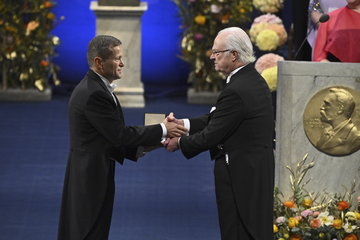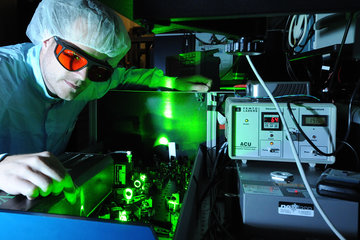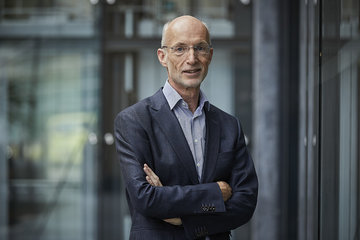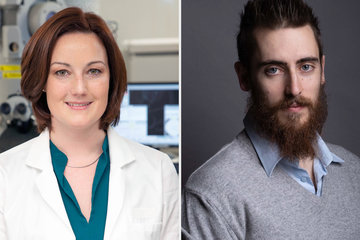Nobel Prize in Physics 2023 for Ferenc Krausz
The scientist from the Max Planck Institute of Quantum Optics is honoured for his contributions to attosecond physics
Ferenc Krausz, director at the Max Planck Institute of Quantum Optics and Professor at the Ludwig Maximilian University of Munich, together with Pierre Agostini and Anne L'Huillier, has been honoured with the 2023 Nobel Prize in Physics. The Nobel Committee is honouring the reserachers for the foundation of attosecond physics. An attosecond is the billionth part of a billionth of a second. Laser pulses lasting only a few attoseconds can be used to track the movements of individual electrons. This not only provides fundamental insights into the behaviour of electrons in atoms, molecules and solids, but could also help to develop electronic components more quickly.

The news of the prize caught Krausz completely by suprise - he learned about it in the morning while preparing for presentations on an open day at the Max Planck Institute of Quantum Optics. 'A prize of this magnitude demands great humility,' he said a press conference in Garching near Munich. President Patrick Cramer extended his warmest congratulations to Krausz: 'This news is truly wonderful and so incredibly well-deserved!'"
In 2001, Ferenc Krausz generated light pulses in the attosecond range (1 attosecond = 10-18 seconds) for the first time, the use of which for observing electron movements in atoms was honoured by the science magazines Nature and Science as one of the 10 most important scientific achievements of 2002.
The basis for this was laid by Ferenc Krausz and his compatriot Robert Szipöcs with the development of mirrors with which extremely intense laser pulses can be generated from a few oscillations of a light wave. In 2002, Ferenc Krausz and Theodor Hänsch, who is also director at the Max Planck Institute of Quantum Optics and professor at the LMU, succeeded in controlling not only the intensity of light pulses but also the phase, i.e. the exact course of a light wave, using the latter's frequency comb technique, which also won a Nobel Prize.
With such intense, perfectly controlled light pulses, which still lasted a few femtoseconds, the researchers led by Ferenc Krausz exerted forces on electrically charged particles such as electrons and protons that correspond to the inner-atomic forces. They now shot these light pulses at noble gas atoms and pulled electrons out of the electron shells of the atoms with the strong electromagnetic fields of the flashes. When the electrons are recaptured, the atoms emit flashes of a few 100 attoseconds. Meanwhile, the shortest light pulses flash for less than 100 attoseconds.
Attosecond physics leads to faster electronics
With the extremely short laser flashes, researchers led by Ferenc Krausz have gained many new insights into the behaviour of electrons. For example, they have observed electrons in the quantum mechanical process of tunnelling. In this process, the charge carriers penetrate an energy barrier that they could not overcome according to the laws of classical physics. The quantum mechanical tunnelling effect is used, for example, in scanning tunnelling microscopes and flash memories on which data is stored in USB sticks. A better understanding of the tunnel effect can help improve its technical application.
Video portrait of Ferenc Krausz
Of fundamental importance was the observation of the positively charged hole left by an electron in a noble gas atom. In the researchers' experiment, certain electrons of the noble gas atoms initially occupied two orbitals simultaneously in a so-called superposition state - according to quantum mechanics, these are the electron's residence spaces. When such an electron is catapulted out of the atom with a strong laser pulse, a pulsating hole remains. The physicists around Ferenc Krausz observed the pulsation directly with a pulse of extremely short-wave ultraviolet light that was only 150 attoseconds long, in other words, they filmed it.
In the meantime, the physicists are also tracking the movement of electrons in metals. For example, they have observed how fast electrons cross individual atomic layers. Such insights help to develop electronic switching elements more quickly.
The high application potential of attosecond laser pulses is now being researched in the Cluster of Excellence Munich-Centre for Advanced Photonics (MAP), a research association comprising LMU, the Technical University of Munich (TUM) and MPQ. The aim is to shed light on the secrets of microscopic movements and to develop new biomedical techniques for the new Centre for Advanced Laser Applications (CALA), which is currently being built on the Garching research campus.
Personal details:
Born in 1962 in Mór (Hungary), Ferenc Krausz studied electrical engineering at the Budapest University of Technology and theoretical physics at Eötvös-Loránd University in Budapest. In 1991 he received his doctorate in quantum electronics from the Vienna University of Technology, where he also habilitated only two years later. From 1999 onwards he was a professor at the Vienna University of Technology, and in 2000 he became director at the Centre for Advanced Light Sources. In 2003, Prof. Krausz followed the call as Director at the Max Planck Institute of Quantum Optics, where he heads the Attosecond Physics Department. Since 2004, he has held a chair in experimental physics at the Ludwig Maximilian University of Munich (LMU).
Prof. Krausz has already received numerous scientific awards, including the Gottfried Wilhelm Leibniz Prize of the German Research Foundation in 2005. In 2006, he received the Quantum Electronics Award of the IEEE Laser and Electro-Optics Society and the Progress Medal of the British Royal Photographic Society. In 2011, he was awarded the "Verdienstkreuz am Bande" of the Federal Republic of Germany. In January 2013, he received the King Faisal International Award, and in August of the same year he was awarded the Otto Hahn Prize, which is jointly awarded by the City of Frankfurt, the Society of German Chemists and the German Physical Society.
Prof. Ferenc Krausz is also a member of numerous scientific associations and academies, such as the Austrian and Hungarian Academy of Sciences or the European Academy of Sciences and Arts in Salzburg. In 2012, he was admitted to the Russian Academy of Sciences and the Academia Europaea.













